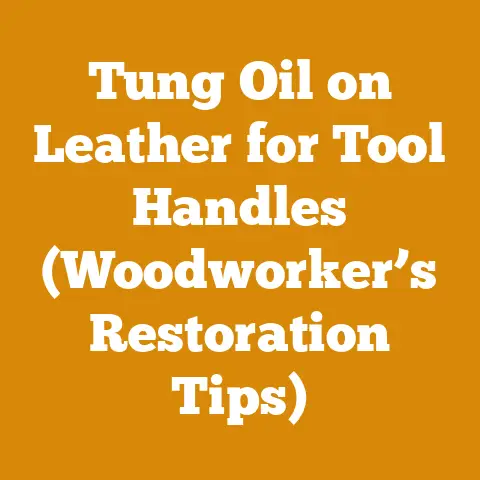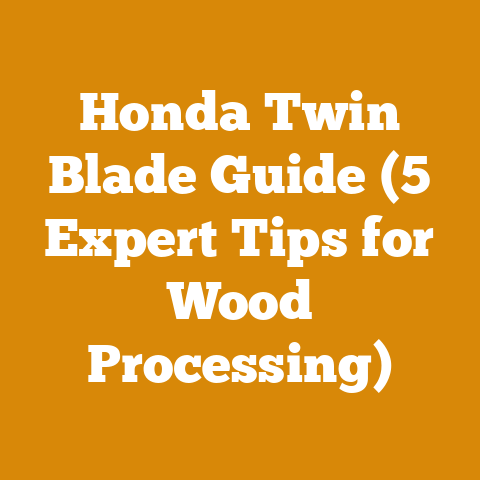Wood Stove Insert vs Wood Stove: Which Heats Better? (Pro Tips)
Introduction: Safety First – A Lesson Learned the Hard Way
Before we even begin to delve into the fiery debate of wood stove inserts versus wood stoves, let’s talk safety. I can’t stress this enough. My own introduction to the world of wood heating came with a rather…memorable…lesson.
Years ago, fresh out of college and brimming with naive confidence, I decided to help a friend clear some land. He had an old, rickety wood stove in his cabin, and I, in my infinite wisdom, volunteered to supply the fuel.
I skipped the proper safety gear, figured I could muscle through, and started swinging away. Long story short, a glancing blow, a dull axe, and a moment of inattention resulted in a rather nasty gash on my leg. It wasn’t life-threatening, thankfully, but it was a painful reminder that respect for the tools and the process is paramount.
That experience, though humbling, taught me invaluable lessons about safety. Now, I always wear appropriate personal protective equipment (PPE) – safety glasses, gloves, chaps, and sturdy boots. I inspect my tools regularly, keep them sharp, and never rush the job.
So, as we explore the world of wood stoves and inserts, remember that safety should always be your top priority. A warm home isn’t worth risking your well-being. Now that we’ve got that covered, let’s dive in.
Wood Stove Insert vs. Wood Stove: Which Heats Better? (Pro Tips)
The question of which reigns supreme – the wood stove insert or the freestanding wood stove – is a common one, and the answer, as you might suspect, isn’t a simple one-size-fits-all solution. It depends on a multitude of factors: your existing fireplace, your heating needs, your budget, and even your personal aesthetic preferences.
I’ve spent years working with both wood stoves and inserts, from helping friends install them in their homes to using them myself in my own workshop. I’ve learned firsthand the pros and cons of each, and I’m here to share my experiences and insights to help you make the best decision for your situation.
Understanding the Basics: Wood Stoves and Inserts Defined
Before we get into the nitty-gritty, let’s define our terms.
-
Freestanding Wood Stove: This is the classic image most people conjure when they think of a wood stove. It’s a self-contained unit, typically made of cast iron or steel, that sits on a hearth or non-combustible surface. It radiates heat in all directions, warming the air around it.
-
Wood Stove Insert: Think of this as a wood stove designed to fit inside an existing masonry fireplace. It’s essentially a firebox with a surround that seals off the fireplace opening. Inserts are designed to be more efficient than traditional fireplaces, directing heat into the room rather than losing it up the chimney.
The Heat is On: Comparing Heating Performance
This is the heart of the matter, isn’t it? Which one provides more warmth? Let’s break it down.
Heating Capacity: BTU and Square Footage
Both wood stoves and inserts are rated by their British Thermal Unit (BTU) output and the square footage they can effectively heat. This is a crucial factor in determining which is right for you.
-
BTU (British Thermal Unit): This measures the amount of heat energy a stove or insert can produce per hour. Higher BTU output generally means more heating power.
-
Square Footage: Manufacturers typically provide an estimated square footage range that a particular model can heat. Keep in mind that this is just an estimate, and the actual performance can vary depending on factors like insulation, climate, and the layout of your home.
Data Point: A typical mid-sized wood stove might have a BTU output of 50,000-60,000 and be rated to heat 1,500-2,000 square feet. A similarly sized insert might have a slightly lower BTU rating but could still heat a comparable area due to its more efficient design.
My Experience: I once helped a friend install a wood stove insert in his drafty farmhouse. He was initially skeptical that it could adequately heat the entire downstairs, but he was pleasantly surprised. The insert, combined with some strategic weather stripping and insulation improvements, transformed the space from a chilly cavern to a cozy haven.
Heating Efficiency: Where the Heat Goes
This is where inserts often have an edge. Traditional fireplaces are notoriously inefficient, with a significant portion of the heat escaping up the chimney. Wood stove inserts are designed to combat this.
-
Closed Combustion System: Inserts have a sealed firebox, which allows for more controlled and complete combustion. This means less wasted fuel and more heat directed into the room.
-
Blower Fans: Many inserts come equipped with blower fans that circulate the heated air, distributing it more evenly throughout the room. This helps to eliminate hot spots and cold spots.
-
Heat Exchange: Some high-end inserts incorporate heat exchangers that further maximize heat transfer. These systems extract even more heat from the exhaust gases before they exit the chimney.
Unique Insight: The efficiency of a wood stove or insert is also heavily influenced by the quality of the wood you burn. Seasoned (dried) wood burns hotter and cleaner than green wood, producing more heat and less creosote buildup in the chimney. More on wood selection later!
Data Point: A traditional open fireplace might have an efficiency rating of only 10-20%, meaning that 80-90% of the heat goes up the chimney. A modern wood stove insert, on the other hand, can achieve efficiency ratings of 70-80% or even higher.
Heat Distribution: Getting the Warmth Where You Need It
The way heat is distributed throughout your home is another important consideration.
-
Freestanding Wood Stoves: These radiate heat outwards in all directions, creating a warm zone around the stove. However, this can lead to uneven heating, with the area closest to the stove being much warmer than other parts of the house.
-
Wood Stove Inserts: With their blower fans and more focused heat output, inserts can often distribute heat more evenly throughout a larger space. They can also be connected to ductwork to distribute heat to other rooms, although this requires more extensive installation.
Case Study: I consulted on a project where a homeowner was struggling to heat their two-story home with a freestanding wood stove. The upstairs rooms were always cold, while the downstairs was overheated. We recommended installing a wood stove insert with ductwork to distribute heat to the upstairs. The result was a much more comfortable and evenly heated home.
The Wood Itself: Fueling the Fire
The type of wood you burn is a critical factor in the performance of any wood-burning appliance. Different wood species have different densities and BTU content.
Hardwoods vs. Softwoods: The Burning Question
-
Hardwoods: These are generally denser and burn longer and hotter than softwoods. Examples include oak, maple, ash, and birch. They are ideal for sustained heating.
-
Softwoods: These burn faster and produce more smoke. Examples include pine, fir, and spruce. They are better suited for kindling or quick bursts of heat.
Data Point: Oak, a popular hardwood, has a BTU content of around 28 million BTUs per cord. Pine, a common softwood, has a BTU content of around 20 million BTUs per cord.
Unique Insight: The moisture content of your wood is just as important as the species. Green wood can have a moisture content of 50% or higher, while seasoned wood should have a moisture content of 20% or less. Burning green wood wastes energy evaporating the water and produces more creosote.
Seasoning Wood: Patience is a Virtue
Seasoning wood involves allowing it to air dry for several months to reduce its moisture content. This process makes the wood burn more efficiently and cleanly.
-
How to Season Wood: Stack the wood in a single row, off the ground, in a sunny and windy location. Cover the top of the stack to protect it from rain and snow, but leave the sides open to allow for air circulation.
-
How Long to Season: The seasoning time depends on the wood species and the climate. Hardwoods typically require at least six months of seasoning, while softwoods can be seasoned in as little as three months.
My Experience: I once made the mistake of burning unseasoned pine in my wood stove. The result was a smoky, inefficient fire that produced a lot of creosote. I learned my lesson the hard way and now always make sure my wood is properly seasoned.
Wood Storage: Keeping Your Fuel Dry
Proper wood storage is essential to prevent it from reabsorbing moisture.
-
Elevated Storage: Store the wood on pallets or racks to keep it off the ground.
-
Covered Storage: Cover the wood to protect it from rain and snow.
-
Ventilated Storage: Allow for air circulation around the woodpile to prevent mold and rot.
Data Point: Properly stored wood can maintain a moisture content of 20% or less for years. Poorly stored wood can reabsorb moisture and become unusable.
Installation Considerations: Getting it Right
The installation process is a critical factor in the performance and safety of both wood stoves and inserts.
Freestanding Wood Stove Installation: A Clear Path
-
Hearth Requirements: Wood stoves require a non-combustible hearth to protect the floor from heat and sparks. The size and thickness of the hearth are determined by the stove’s manufacturer.
-
Clearances: Wood stoves must be installed with specific clearances from combustible materials, such as walls and furniture. These clearances are also specified by the manufacturer.
-
Chimney Connection: The stove must be connected to a properly sized and installed chimney. The chimney provides draft for combustion and vents exhaust gases.
Unique Insight: Chimney height is crucial for proper draft. A chimney that is too short may not provide enough draft, while a chimney that is too tall may create excessive draft.
Wood Stove Insert Installation: Fitting the Puzzle
-
Fireplace Inspection: Before installing an insert, the existing fireplace and chimney must be inspected to ensure they are in good condition and meet safety standards.
-
Chimney Liner: Most inserts require a stainless steel chimney liner to be installed inside the existing chimney. This liner protects the chimney from corrosion and ensures proper draft.
-
Sealing the Opening: The insert must be properly sealed to the fireplace opening to prevent air leakage and maximize efficiency.
Case Study: I assisted with an insert installation where the homeowner tried to save money by skipping the chimney liner. The result was a dangerous situation with excessive creosote buildup and poor draft. They eventually had to hire a professional to install the liner, negating any initial cost savings.
Professional Installation: When to Call in the Experts
While some experienced DIYers may be comfortable installing a wood stove or insert themselves, it’s often best to hire a professional. A professional installer will ensure that the installation is done correctly and safely, and they can also help you choose the right stove or insert for your needs.
Data Point: Improperly installed wood stoves and inserts are a leading cause of house fires. Hiring a professional installer can significantly reduce this risk.
Cost Analysis: Weighing the Investment
The cost of a wood stove or insert includes the purchase price, installation costs, and ongoing fuel costs.
Purchase Price: What You’ll Pay Upfront
-
Freestanding Wood Stoves: These generally range in price from $800 to $4,000, depending on the size, features, and brand.
-
Wood Stove Inserts: These typically cost more than freestanding stoves, ranging from $1,500 to $5,000.
Unique Insight: Don’t just focus on the initial purchase price. Consider the long-term cost of ownership, including fuel costs, maintenance, and potential repairs.
Installation Costs: Paying for Expertise
-
Freestanding Wood Stove Installation: This can range from $500 to $2,000, depending on the complexity of the installation.
-
Wood Stove Insert Installation: This is typically more expensive than freestanding stove installation, ranging from $1,000 to $3,000, due to the need for a chimney liner and other specialized work.
Data Point: Professional installation can add 20-50% to the total cost of a wood stove or insert. However, it can also save you money in the long run by ensuring efficient and safe operation.
Fuel Costs: The Ongoing Expense
-
Wood Costs: The cost of firewood varies depending on location, wood species, and the quantity purchased.
-
Electricity Costs: Some wood stoves and inserts require electricity to operate the blower fan.
My Experience: I’ve found that buying firewood in bulk during the off-season can save you a significant amount of money. I also try to split and stack my own wood whenever possible to reduce costs.
Long-Term Savings: The Payoff
While the initial investment in a wood stove or insert can be significant, it can also provide long-term savings on heating costs.
Case Study: A homeowner who switched from oil heating to a wood stove saved over $2,000 per year on their heating bills. The wood stove paid for itself in just a few years.
Aesthetics: Finding the Right Look
Beyond performance and cost, the aesthetics of a wood stove or insert are also important.
Freestanding Wood Stoves: A Focal Point
-
Traditional Designs: These often feature ornate castings and a classic look.
-
Modern Designs: These tend to be more streamlined and minimalist.
-
Color Options: Wood stoves are available in a variety of colors and finishes to match your décor.
Unique Insight: Consider the overall style of your home when choosing a wood stove. A rustic stove might look out of place in a modern home, and vice versa.
Wood Stove Inserts: Seamless Integration
-
Flush-Mount Designs: These sit flush with the fireplace opening for a clean, integrated look.
-
Protruding Designs: These extend out into the room, providing more radiant heat.
-
Decorative Surrounds: Inserts are available with a variety of decorative surrounds to complement your fireplace.
Data Point: The aesthetic appeal of a wood stove or insert can significantly impact the resale value of your home.
Maintenance: Keeping the Fire Burning Bright
Regular maintenance is essential to keep your wood stove or insert operating safely and efficiently.
Chimney Sweeping: Preventing Creosote Buildup
-
Frequency: The chimney should be swept at least once a year, or more often if you burn a lot of wood.
-
Professional Sweeping: It’s best to hire a professional chimney sweep to ensure the job is done correctly.
-
Creosote Hazards: Creosote is a flammable substance that can build up in the chimney and cause a fire.
My Experience: I once neglected to have my chimney swept for several years, and the creosote buildup became so severe that it started to restrict the draft. I learned my lesson and now make sure to schedule a chimney sweeping every year.
Ash Removal: Keeping Things Clean
-
Frequency: Ash should be removed regularly, as it can reduce the efficiency of the stove or insert.
-
Safe Disposal: Dispose of ashes in a metal container with a tight-fitting lid.
-
Ash Uses: Wood ash can be used as a fertilizer in the garden.
Unique Insight: Never use a vacuum cleaner to remove ashes, as they can contain hot embers that could ignite a fire.
Gasket Replacement: Maintaining a Tight Seal
-
Gasket Function: The gaskets around the door and glass of a wood stove or insert create a tight seal, preventing air leakage.
-
Gasket Inspection: Inspect the gaskets regularly for wear and tear.
-
Gasket Replacement: Replace worn gaskets to maintain efficiency and prevent air leakage.
Data Point: Worn gaskets can reduce the efficiency of a wood stove or insert by as much as 20%.
Making the Decision: Which is Right for You?
So, after all this, which is the better choice: a wood stove insert or a freestanding wood stove? As I said at the beginning, it depends on your specific needs and circumstances.
Here’s a quick recap to help you decide:
Choose a Freestanding Wood Stove If:
- You don’t have an existing fireplace.
- You want a focal point in your room.
- You prefer the radiant heat of a wood stove.
- You have ample space for clearances.
- You want a potentially lower upfront cost.
Choose a Wood Stove Insert If:
- You have an existing fireplace that you want to make more efficient.
- You want more even heat distribution.
- You want to maximize heating efficiency.
- Aesthetics are important and you want a seamless look.
- You’re willing to invest more upfront for long-term savings.
Final Thoughts:
Ultimately, the best way to determine which is right for you is to consult with a qualified professional. They can assess your specific needs and recommend the best solution for your home. Remember to prioritize safety, choose quality wood, and maintain your stove or insert properly to enjoy years of warmth and savings.
And remember my early lesson: always respect the tools and the process. Happy burning!






